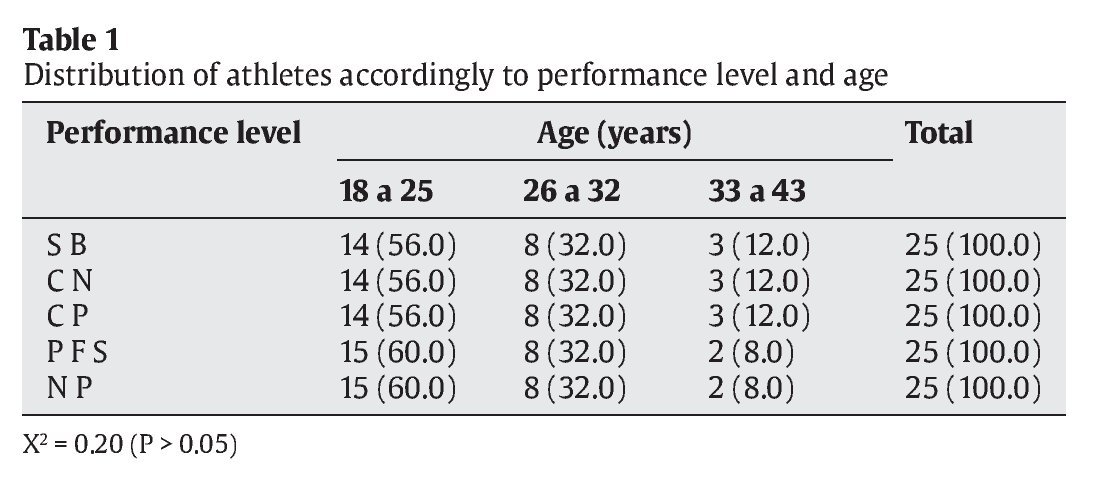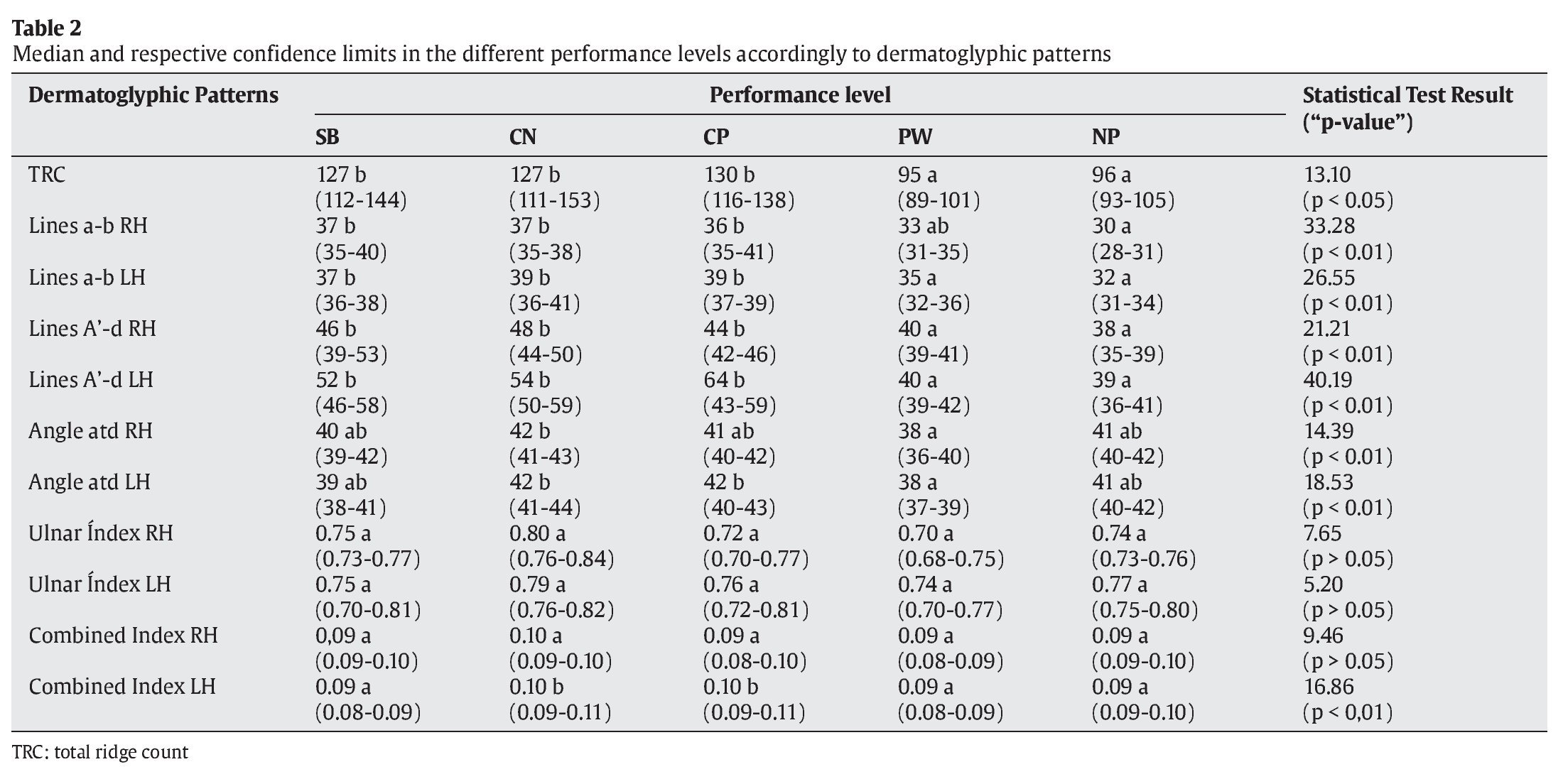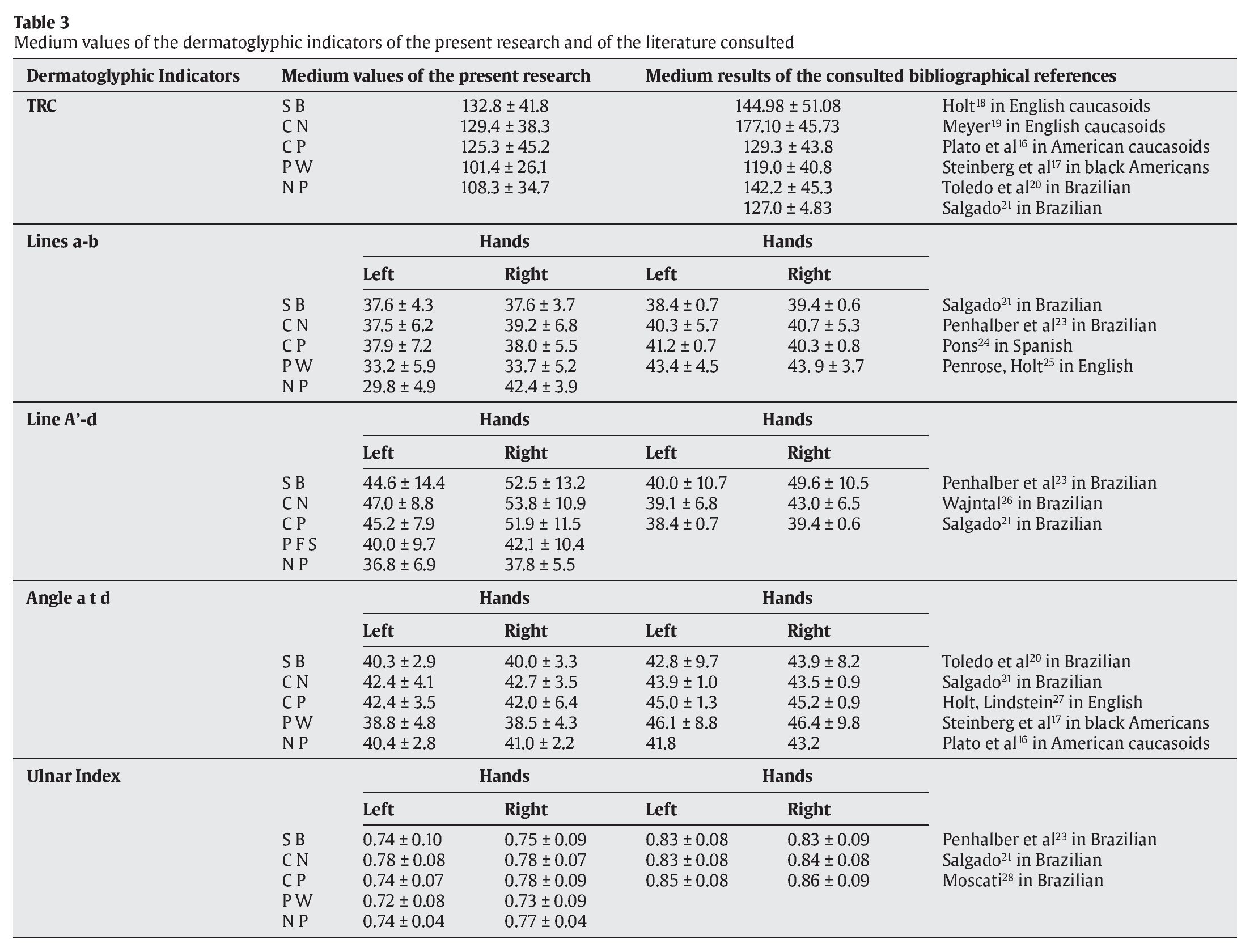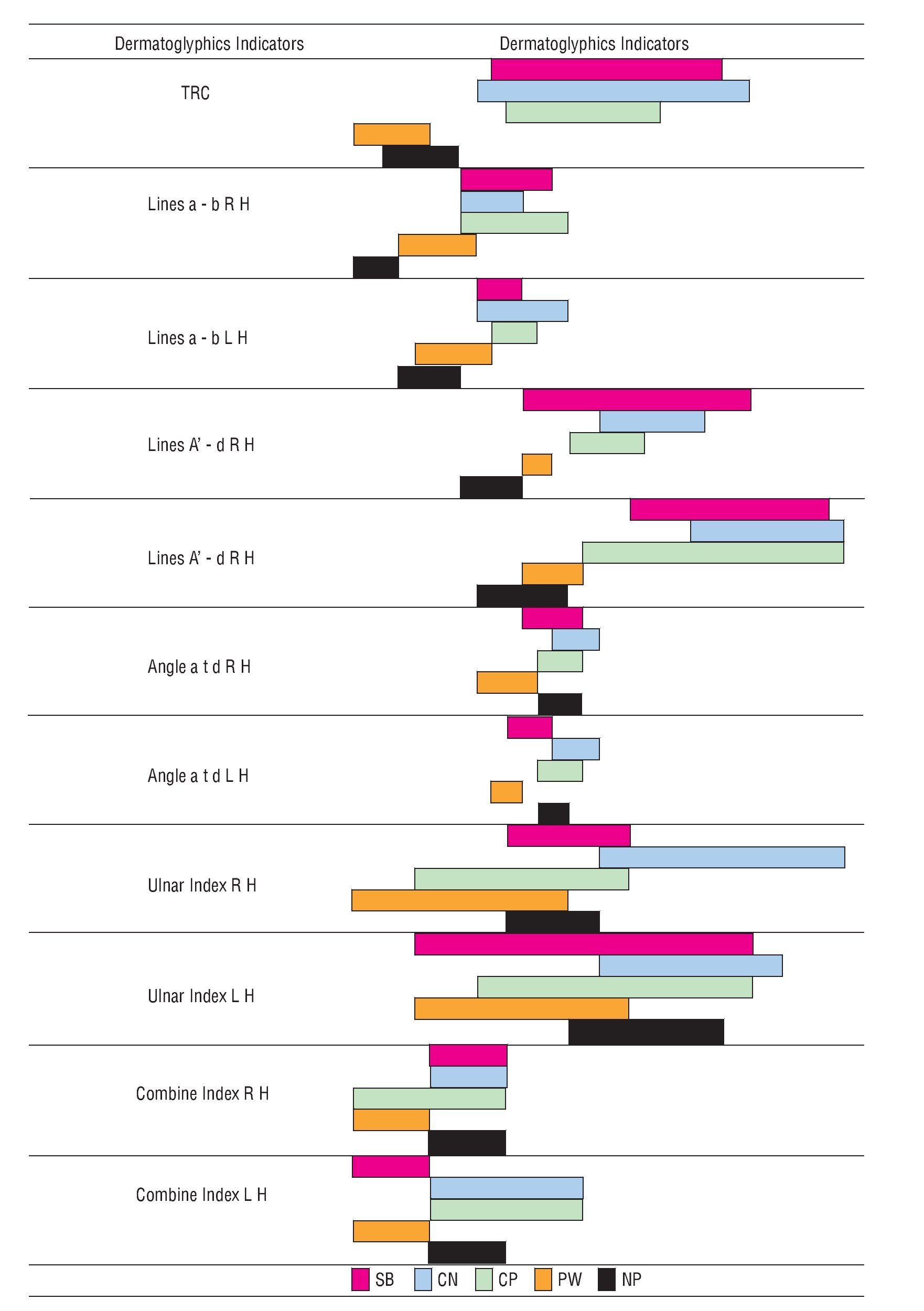Objectives. One of the concerns of Sports Sciences is the search for methodologies that can help discover potential athletes. In this sense, some initiatives have been taken in an attempt to identify and characterize the genetic profile of dermatoglyphic marks (fingerprints). The present work has the objective of understanding the distribution of quantitative dermatoglyphic indicators in basketball players with different levels of performance compared to non-players.
Methods. The subjects observed constituted 125 individuals, divided into five numerically equal groups, three of which were composed of professional basketball players according to their level of participation (Brazilian Team, National Championship and São Paulo Championship) and the last two formed by weekend players and non-players, respectively. Eleven dermatoglyphic variables were analysed in the descriptive level by means of measurement of position, variability and limits of confidence of the median, and, in inferential terms, the Kruskal-Wallis statistical test was adopted.
Results. The more expressive ones were: TRC, counting lines a-b and A'-d, behave differently between athletes and non-athletes.
Conclusion. Studies about this kind of analysis should be continued, calling on resources that take into consideration all variables simultaneously as a multivariate study.
Objetivo. Una de las preocupaciones de las ciencias del deporte es buscar metodologías que puedan ayudar a descubrir atletas en potencia. En este sentido, algunas iniciativas se han llevado a cabo con la intención de identificar y caracterizar el perfil genético de las marcas dermatoglíficas (huellas dactilares). El presente trabajo tiene como objetivo entender la distribución cuantitativa de indicadores dermatoglíficos en jugadores de baloncesto con diferentes niveles de rendimiento, en comparación con los no jugadores.
Métodos. Los sujetos observados fueron 125, divididos en 5 grupos numéricamente iguales, 3 de los cuales estaban compuestos por jugadores profesionales de baloncesto, de acuerdo con su nivel de participación (la selección de Brasil, Campeonato Nacional y campeonato Paulista), los 2 últimos grupos formados por jugadores de fin de semana y no jugadores, respectivamente. Fueron colectadas 11 variables dermatoglíficas (TRC y en las manos derecha e izquierda, las líneas ab y A'-d, el ángulo atd, ulnar e índice combinado) que fueron analizadas a nivel descriptivo, a través de las medidas de variabilidad y dispersión, y los límites de confianza de la mediana, y, en términos inferenciales, fue adoptada la prueba estadística de Kruskal-Wallis.
Resultados. Los más significativos fueron el TRC y contar las líneas ab y A'-d con comportamiento diferente entre los atletas y no atletas.
Conclusion. A estudios sobre este tipo de análisis, se les debe dar continuidad, principalmente por la utilización de los recursos que consideran todas las variables simultáneamente, como el estudio multivariado.
Introduction
Today, one of the concerns of Sports Sciences is the search for methodologies that can help discover potential athletes. Despite the small advance noticed, some isolated situations have been optimised in the attempt to find talented young people, as in programs elaborated in Cuba and by the Cologne School in Germany1.
Some limitations and difficulties have been observed in different proposals because of the influence of different factors like cultural characteristics, policy priorities, small use of efficient statistical models and precipitation in analysing results, which could interfere positively as well as negatively. With regard to this, Platonov, Fessenko2 point out that discovery as well as orientation do not always occur at the same time, in one or other stage of improvement, but actually are part of the overall career.
It is immediately evident that we are dealing with a multifactor phenomenon and that control and recognition of some angles is of fundamental importance since high performance in sports can only be attained by six to ten years of planned and systematic preparation3. Traditionally above all detection of talent is done by observations of trainers during games using empirical procedures that are frequently source of errors - their results on selection process should be confirmed by choosing adequate scientific strategies4.
In the sports field, authors like Moskatova5 emphasise that, although it might be highly perfected, training technology does not modify what has been determined by the athlete's individual organic capacity; the efficacious option in the problematic of talent selection is knowledge about biological concepts and models (human genomics, physical anthropology, sports morphology, among others).
Along this line, some initiatives have been utilized to try to identify and describe genetic profile by means of dermatoglyphic marks (fingerprints) of different athletes and sports. Stemmed mainly from the Eastern world, only in recent years they have been repeated here. Respective raised interests have been mostly just local or regional, because of their descriptive nature, the non adoption of the international Penrose Memorandum6, lack of information about specifics in the assessment and classification, utilisation of limited resources like non adoption of palm analysis, and operation of a small number of observed situations.
In this sense, the present work tries to understand the distribution of quantitative dermatoglyphic indicators of basketball players in different levels of performance and of non-players.
Method
125 individuals were observed in this study. They were divided into five numerically equal groups. Three of these consisted of professional basketball players according to the respective levels of participation: i) Brazilian National Team (SB); ii) National Championship (CN); iii) São Paulo Championship (CP). The other two consisted of: i) weekend players (PW); ii) non-players (NP). Table 1 shows athletes´ distribution by performance level and age. X2 analysis indicates homegeneity of such grups according to mentioned variables.
Brazilian National Team (SB) group was considered elite of the sport because had already gained fame during the National Championship. Technical Commission of the Brazilian Basketball Confederation (CBB) selects them according to technical criteria. This group was made up of players who had already played for Brazil in international events like the Olympic Games or World Championships.
The group of National Championship (CN) players consisted of atlethes who had not yet been selected to play in the Brazilian National Team (SB). This level of competition (CN) is understood to be the maximum event of the sport because it brings together outstanding teams of year in the adult category. This level of players is promoted by the CBB, and it is governed by norms of International Basketball Federation. It includes 14 teams: the state champions of Santa Catarina, Parana, Rio Grande do Sul and Minas Gerais; the three best teams of Rio de Janeiro; the six best of São Paulo; and the previous year's Brazilian champion.
The third group of players in São Paulo Championship followed pertinent criteria in selection of individuals. Excluding criteria included non-participation in National Championship games as well as not being selected for Brazilian Selection team. Thus, of thirteen participating teams, six were removed because they were already classified for the National Championship. Players were chosen from the three last teams according to the criteria for inclusion being researcher's accessibility and personal consent. Regarding the Championship, this event is denominated Male Adult Special Division - series A1, the most coveted state competition of the sport, which is always held in the second semester of each year. Promotion and organization are handled by São Paulo Basketball Federation according to the General Regulations of the International Basketball Federation; it is made up of 13 teams: the 11 best classified teams from the year before and the champion and vice-champion of the division immediately below, that is, A2, of the same year.
The fourth group, called weekend players (PW), had 25 individuals according to the following criteria for inclusion: i) play the sport as recreation, principally on weekends; ii) non-participation in teams organized for competition; iii) similar characteristics of age, height and race.
The fifth group of non-players (NP) was selected according to the criteria of non compliance with criteria established for the other groups and similar characteristics of age and race.
The collection of fingerprints observed the protocol systematised by Cummins, Midlo (1961)7, following the ethical procedures of the pertinent Brazilian legislation, especially the Terms of Informed Consent. Black ink was used to impregnate the fingerprint corrugations, which were then printed on white paper. After fingerprints were taken separately, impression of fingers/palm of each hand was taken as many times as necessary for a clear impression, subsequently analysed under magnifying glass observation. Then, these data were put into its specific protocol and saved in a computer data bank.
Finally, each one of the variables was analysed separately to verify the differentiation of the various performance levels according to quantitative dermatoglyphic indicators. The following procedure was adopted: i) in the descriptive ambit, results were presented by measurement of position, variability and confidence limits for median; and, ii) in inferential terms, non parametric statistics test of Kruskal-Wallis8 was used to compare the groups. The study utilized a chart with the results of the statistics test and an abacus of the confidence limits (95%) for the median. For indications of the result of the values presented by the statistics test, low case letters to the side of the averages were used, considering the alphabetic sequence as associated to an increasing order of magnitude. In order to interpret the small letters, the procedure is: two median (or frequencies) followed by at least the same letter do not differ among themselves at level of 5% of the value.
Results
Table 2 and figure 1 show median values and their respective limits of confidence (95%) in different performance levels according to the dermatoglyphic pattern analysed, noticing that TRC, line count of a-b and A'-d have a different comportment when players are compared to non-players in right (RH) and left (LH) hands.
Fig. 1. Abacus of medians values and their limits of confidence in different performance levels according to quantitative dermatoglyphic indicators.
Discussion
Herewith presented data clearly indicates that: i) TRC and the line count of a-b and A'-d dermatoglyphic indicators comport themselves differently between players and non-players; ii) it would be good to continue studies of the analysis made by employing resources that take into consideration all variables simultaneously as a multivariable study.
In relation to Brazilian information avaliable on dermatoglyphics in Sport Science, it is observed that, as a matter of fact, they only refer absolute and relative frequence distributions of patterns and TRC, what is a limitation that reduces many possible contributions. In an investigation of some physical and psycological aspects of the Brazilian Handball Adult Women´s team, Cunha Jr. et al9 reported slightly different percentages of finger arches, loops and whorls based on the player´s position on the court.
Meneses and Fernandes Filho10 proposed to identify and compare the dermatoglyphic characteristics and basic physical qualities of Brazilian athletes of several qualification levels in rhythmic gymnastics. As for dermatoglyphic variables, mean values varied widely from 173.43 ± 21.62 in the Brazilian Team to 75.43 ± 51.57 in National Championship players and 71.71 ± 37.10 in State Championship athletes.
In another study, Fonseca et al11 sought to determine a set of features including dermatoglyfics in twenty-eight female volleyball high-performance athletes. They showed that the frequency of occurrence of arch was 11%, 60% of loops and whorls, 29%.
Díaz and Espinoza12 sought to establish relationships between fingerprint patterns and fitness for members of a Center of Initiation and Specialisation in Track and Field in Chile: results showed strong association between fitness and genetic profile and male sprinters had values for loops of 18.5 ± 24.0; 1.0 ± 0.8 for arches; 3.17 ± 4.6 for whorl and 72.83 ± 13.9 for TRC. For runners results revealed: loops, 6.0 ± 2.8; arches 1.57 ± 3.5; whorls 2.43 ± 1.6 and 93.93 ± 47.3 for TRC.
There are some initiatives that characterized the dermatoglyphic patterns in non-athetes. Santos and Fernandes Filho13 from members of the Police Special Operations Battalion have gotten mean values of 111.39 ± 31.05 for TRC and percentages of patterns as follows: arch, 17.4%; loops 62.1% and whorls, 20.4%. Nishioka et al14 found in dancers percentage of 65.0% for loops, 35.0% for whorls and 135.1 for TRC. Passos et al15 in health individuals in a gym had percentages of 17% of arches; 63% of loops and 20% of whorls, while mean TRC was 125.92 ± 50.38.
Analysing separatedly from diverse quantitative dermatoglyphic indicators obtained from individuals with different performance levels in comparison with the international literature (table 3), it can be noted that some results are concordant and in other situations, discordant. Regarding TRC in particular, it was verified that, although the values observed in the median presented a difference between groups of players and non-players, when they were compared with those presented in table 3, they seem to be close to the numbers presented by Plato et al16 and Steinberg et al17 who had described the values of normal individuals in the American population, Caucasian as well as Black. The works of Holt18 and Meier19 present scores of normal English Caucasians well above those related here, in spite of a significant difference of numbers between those works being observed. In other Brazilian studies, data of Toledo et al20 referring to normal individuals in the São Paulo population are situated above references to all performance levels. Data presented by Salgado21 were collected from students and staff of the School of Medicine at the University of São Paulo and are closer to that of the players. According to Saldanha22, the extensive individual variation in TRC could be due to the average counting of lines in each one of the ten fingers being distributed between eleven and twenty lines, which in the total of the fingers could vary between zero and 300 lines. Furthermore, he points out that the counts are slightly higher in the right hand compared with the left.
A peculiarity of this study is that race has not been controlled and its relationship to differences of distribution of fingerprints must be considered (v.g. Sachs Bat-Miriam29; Glanville, Poelding30). In fact assessing colour and standardizing racial classification of individuals is a real problem. This is especially a difficulty in Brazil, which is considered a racial laboratory because of the mixtures of White with Black, White with Indian, Black with Indian and the respective mixtures of their descendents - one grand genetic heterogeneity. As a matter of fact, Krieger et al31, while studying families from the Brazilian Northeast and Tavares Neto32 individuals from Brasilia, indicate that assessment of race ought to be based on the pigmentation of the abdomen, colour and type of hair, and conformation of the nose and lips.
IBGE33 demographic census adopts the following criteria of White, Mulatto, Black and Yellow (only for people of oriental origin) and Indigenous; the colour noted down in the questionnaire was the one informed by the individual being interviewed and not the perception of the interviewer. In the international scene, Cummins, Midlo7 relate that the majority of studies made in Europe situate individuals as White, Yellow-Brown and Black. Meier19 (1975) studied Americans using the more extensive classification of Whites and Non-Whites. According to Pereira34, the application of racial distributions requires standardization since individuals differ in their assessment of human characteristics.
Another greatly limited item that was observed consists of dealing with the indicators in an isolated way, that is, by an analysis model that separately observes each one of the variables studied. According to Mulvihill, Smith35, dermatoglyphic criteria are determined statistically for populations and not for individuals; furthermore, they point out that correlations of the indicators with specific illnesses could be accidental. Thus, although this constitutes an easy way to work from the statistical point of view, the independent analysis of data is simplistic in the biological field.
Regarding this matter, Bergamo, Paes36 call attention to the limitations of using univaried analysis, principally for models that give greater relevancy to physical aspects and do not consider items like the division of basic categories and knowledge of the levels of influence of growth and development in the most expressive variations of the sport, among others.
In the field of sports, different factors in the diverse types of sports influence the athlete in reaching his best performance level. These range from physical dimensions, technique, tactics and psychology, as well as structure, organization and controlled training planning. Therefore, analysis of each variable isolated could lead to great errors.
Matsudo1 relates that, in order to have interaction between variables which assume different levels of influence according to the sport, it is very important to know the real specifics like profile of the sport or team, characteristics of the group of players with determined functions in competitive sports, as for example forwards, guards and centres in basketball, or even in individual sports like running, a situation in which profile of athlete is essential. Furthermore, he declares that some variables assume results that are more distant from the population's averages and are considered more important, like maximum consumption of oxygen in marathoners and leg strength for jumpers; consequently, they deserve greater attention in detecting and monitoring outstanding performance.
In this sense, there is a greater need to use multivariate statistical analysis, understanding that this model simultaneously considers all the variables and, therefore, offers greater consistency in the data and robust results. Although this constitutes a mathematical construct that is more complex to operate, from the biological point of view results are more realistic37. Multivaried analysis is not simply a sum of univaried results but rather their empowering.
It ought to be noticed that some aspects can be better studied like comparing fingerprints indicators between sports that use the hands and basketball, considering possible relation between dermatoglyphic and the differential prehensile physiological function involved. That means a more detailed approach points to a dermatoglyphic comparison between the different positions that the athletes play in games, thus aiding the specificity of the sport.
History of the article:
Received January 29, 2012 Accepted April 17, 2012
Correspondence:
Aguinaldo Gonçalves Rua.
E-mail:
aguinaldogon@uol.com.br











